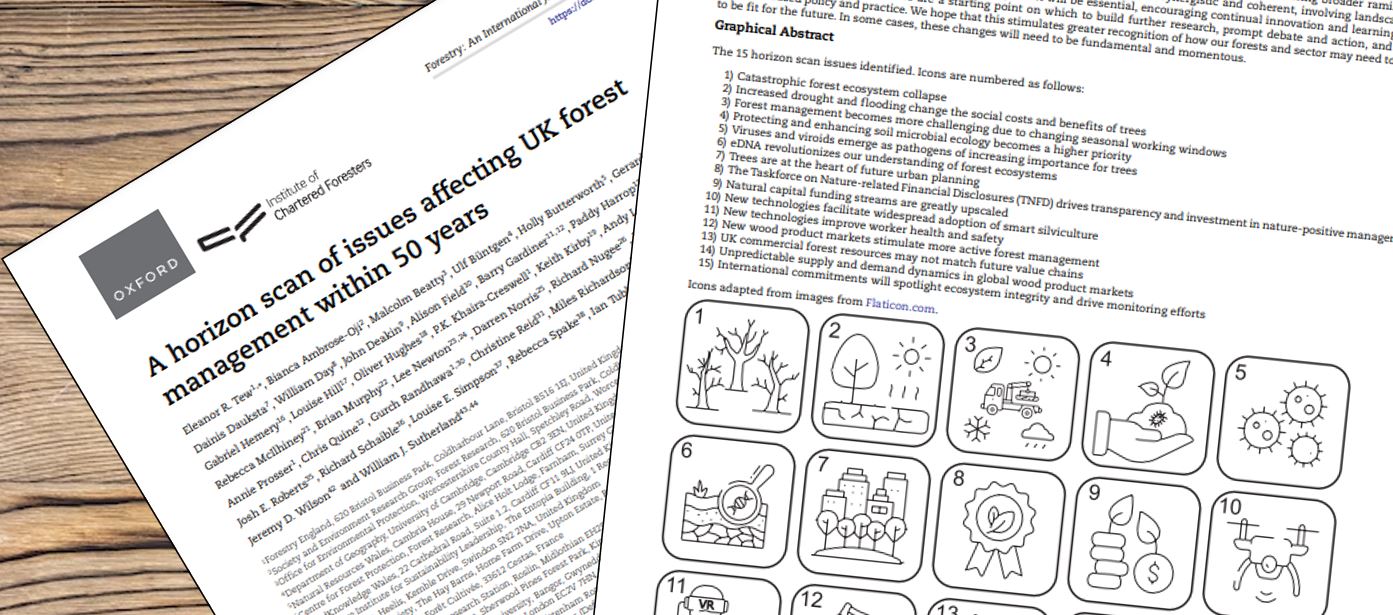
We were pleased to be part of the team of experts that recently published a list of 15 overlooked and emerging issues that are likely to have a significant impact over the next 50 years if action is not taken.
Horizon scanning is a technique to identify relatively unknown threats, opportunities, and new trends and the aim is to help researchers, practitioners, policymakers, and society in general, better prepare for the future and address threats before they become critical. The findings are published in the journal Forestry (open access) (1).
The headlines covering this story along the lines of “UK forests face catastrophic ecosystem collapse within 50 years” do sound scary, but the point is to prevent this and other problems by acting now. This needs a range of skills, views and approaches so we encourage researchers from all fields to read the paper and consider where their expertise can help.
The main task of pulling this all together was achieved by first author Dr Eleanor Tew (visiting researcher at Cambridge’s Department of Zoology and Head of Forest Planning at Forestry England) who said: “The next 50 years will bring huge changes to UK forests: the threats they face, the way that we manage them, and the benefits they deliver to society. These results are both concerning and exciting. However, we should be optimistic, remembering that these are possibilities and not certainties. Crucially, we have time to act ‒ by responding to the threats and embracing the opportunities, future generations can have resilient forests with all the benefits they offer.”
Our work mostly connects with three of the issues:
12) New wood product markets stimulate more active forest management;
13) UK commercial forest resources may not match future value chains;
14) Unpredictable supply and demand dynamics in global wood product markets.
In particular “Strategic Integrated Research in Timber” and “Building from England’s Woodlands” have been looking at the current and future timber supply in the UK, the possibilities for species diversification, and the effects of forest management and climate on wood properties. These three issues are also touched on in the short article “What future is the forest growing” of the 2021 UK Forest Market Report (John Clegg & Co and Tilhill).
Hopefully, colleagues in Edinburgh Napier’s Centre for Conservation and Restoration Science can help also with some of the other issues.
Working with the expert group was enlightening because they represented a wide range of expertise and interests – but the one thing in common was the enthusiasm for forests and the concern for safeguarding their future by acting now.
(1) Eleanor R Tew, Bianca Ambrose-Oji, Malcolm Beatty, Ulf Büntgen, Holly Butterworth, Gerard Clover, Dan Cook, Dainis Dauksta, William Day, John Deakin, Alison Field, Barry Gardiner, Paddy Harrop, John R Healey, Rebecca Heaton, Gabriel Hemery, Louise Hill, Oliver Hughes, P K Khaira-Creswell, Keith Kirby, Andy Leitch, John MacKay, Rebecca McIlhiney, Brian Murphy, Lee Newton, Darren Norris, Richard Nugee, John Parker, Gillian Petrokofsky, Annie Prosser, Chris Quine, Gurch Randhawa, Christine Reid, Miles Richardson, Daniel J Ridley-Ellis, Rachel Riley, Josh E Roberts, Richard Schaible, Louise E Simpson, Rebecca Spake, Ian Tubby, Julie Urquhart, Fabian Wallace-Stephens, Jeremy D Wilson, William J Sutherland, A horizon scan of issues affecting UK forest management within 50 years, Forestry: An International Journal of Forest Research, 2023; https://doi.org/10.1093/forestry/cpad047
